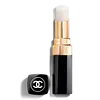What's inside
What's inside
 Key Ingredients
Key Ingredients

 Benefits
Benefits

 Concerns
Concerns

 Ingredients Side-by-side
Ingredients Side-by-side

Bis-Behenyl/Isostearyl/Phytosteryl Dimer Dilinoleyl Dimer Dilinoleate
EmollientPhytosteryl/Octyldodecyl Lauroyl Glutamate
Skin ConditioningPentaerythrityl Tetraethylhexanoate
EmollientDiisostearyl Malate
EmollientCaprylic/Capric Triglyceride
MaskingSqualane
EmollientIsotridecyl Isononanoate
EmollientSynthetic Wax
AbrasiveEthylene/Propylene Copolymer
AbrasiveMeadowfoam Delta-Lactone
Skin ConditioningSorbitan Isostearate
EmulsifyingLauryl PCA
HumectantTocopheryl Acetate
AntioxidantParfum
MaskingSilica
AbrasiveTocopherol
AntioxidantAlumina
AbrasiveCI 77891
Cosmetic ColorantMica
Cosmetic ColorantBis-Behenyl/Isostearyl/Phytosteryl Dimer Dilinoleyl Dimer Dilinoleate, Phytosteryl/Octyldodecyl Lauroyl Glutamate, Pentaerythrityl Tetraethylhexanoate, Diisostearyl Malate, Caprylic/Capric Triglyceride, Squalane, Isotridecyl Isononanoate, Synthetic Wax, Ethylene/Propylene Copolymer, Meadowfoam Delta-Lactone, Sorbitan Isostearate, Lauryl PCA, Tocopheryl Acetate, Parfum, Silica, Tocopherol, Alumina, CI 77891, Mica
Petrolatum
EmollientRicinus Communis Seed Oil
MaskingOzokerite
Emulsion StabilisingGlyceryl Rosinate
PerfumingEthylhexyl Dimethyl Paba
UV AbsorberCetyl Lactate
EmollientLanolin Oil
EmollientMyristyl Lactate
EmollientBenzophenone-3
UV AbsorberCetyl Acetate
EmollientEuphorbia Cerifera Wax
Copernicia Cerifera Wax
Myristyl Alcohol
EmollientAcetylated Lanolin Alcohol
EmollientBeeswax
Emulsion StabilisingCaprylyl Glycol
EmollientMethylstyrene/Vinyltoluene Copolymer
Microcrystalline Wax
Emulsion StabilisingParfum
MaskingTocopherol
AntioxidantVegetable Oil
Skin ConditioningZea Mays Oil
EmulsifyingBHT
AntioxidantCitral
PerfumingCitronellol
PerfumingGeraniol
PerfumingLimonene
PerfumingLinalool
PerfumingPhenoxyethanol
PreservativeIron Oxides
CI 77891
Cosmetic ColorantPetrolatum, Ricinus Communis Seed Oil, Ozokerite, Glyceryl Rosinate, Ethylhexyl Dimethyl Paba, Cetyl Lactate, Lanolin Oil, Myristyl Lactate, Benzophenone-3, Cetyl Acetate, Euphorbia Cerifera Wax, Copernicia Cerifera Wax, Myristyl Alcohol, Acetylated Lanolin Alcohol, Beeswax, Caprylyl Glycol, Methylstyrene/Vinyltoluene Copolymer, Microcrystalline Wax, Parfum, Tocopherol, Vegetable Oil, Zea Mays Oil, BHT, Citral, Citronellol, Geraniol, Limonene, Linalool, Phenoxyethanol, Iron Oxides, CI 77891
 Reviews
Reviews

Ingredients Explained
These ingredients are found in both products.
Ingredients higher up in an ingredient list are typically present in a larger amount.
Ci 77891 is a white pigment from Titanium dioxide. It is naturally found in minerals such as rutile and ilmenite.
It's main function is to add a white color to cosmetics. It can also be mixed with other colors to create different shades.
Ci 77891 is commonly found in sunscreens due to its ability to block UV rays.
Learn more about CI 77891Parfum is a catch-all term for an ingredient or more that is used to give a scent to products.
Also called "fragrance", this ingredient can be a blend of hundreds of chemicals or plant oils. This means every product with "fragrance" or "parfum" in the ingredients list is a different mixture.
For instance, Habanolide is a proprietary trade name for a specific aroma chemical. When used as a fragrance ingredient in cosmetics, most aroma chemicals fall under the broad labeling category of “FRAGRANCE” or “PARFUM” according to EU and US regulations.
The term 'parfum' or 'fragrance' is not regulated in many countries. In many cases, it is up to the brand to define this term.
For instance, many brands choose to label themselves as "fragrance-free" because they are not using synthetic fragrances. However, their products may still contain ingredients such as essential oils that are considered a fragrance by INCI standards.
One example is Calendula flower extract. Calendula is an essential oil that still imparts a scent or 'fragrance'.
Depending on the blend, the ingredients in the mixture can cause allergies and sensitivities on the skin. Some ingredients that are known EU allergens include linalool and citronellol.
Parfum can also be used to mask or cover an unpleasant scent.
The bottom line is: not all fragrances/parfum/ingredients are created equally. If you are worried about fragrances, we recommend taking a closer look at an ingredient. And of course, we always recommend speaking with a professional.
Learn more about ParfumTocopherol (also known as Vitamin E) is a common antioxidant used to help protect the skin from free-radicals and strengthen the skin barrier. It's also fat soluble - this means our skin is great at absorbing it.
Vitamin E also helps keep your natural skin lipids healthy. Your lipid skin barrier naturally consists of lipids, ceramides, and fatty acids. Vitamin E offers extra protection for your skin’s lipid barrier, keeping your skin healthy and nourished.
Another benefit is a bit of UV protection. Vitamin E helps reduce the damage caused by UVB rays. (It should not replace your sunscreen). Combining it with Vitamin C can decrease sunburned cells and hyperpigmentation after UV exposure.
You might have noticed Vitamin E + C often paired together. This is because it is great at stabilizing Vitamin C. Using the two together helps increase the effectiveness of both ingredients.
There are often claims that Vitamin E can reduce/prevent scarring, but these claims haven't been confirmed by scientific research.
Learn more about Tocopherol